Engine Performance and Emissions Analysis in a Cold, Intermediate and Hot Start Diesel Engine
Abstract
:1. Introduction
2. Experimental Procedure
2.1. Custom Designed Experimental Cycle
2.2. Experimental Set Up
2.3. Emissions Apparatus and Repeatability of Experiments
3. Results and Discussion
3.1. Engine Coolant and Oil Temperature
- Stage 1—Engine cold start (coolant and oil < 70 °C);
- Stage 2—Engine intermediate start—I (70 °C < coolant < 90 °C and oil < 70 °C);
- Stage 3—Engine intermediate start—II (coolant > 90 °C and 70 °C < oil < 90 °C);
- Stage 4—Engine hot start (coolant > 90 °C and oil > 90 °C).
3.1.1. Stage 1—Engine Cold Start (Coolant and Oil < 70 °C)
3.1.2. Stage 2—Engine Intermediate Start—I (70 °C < Coolant < 90 °C and Oil < 70 °C)
3.1.3. Stage 3—Engine Intermediate Start—II (Coolant > 90 °C and 70 °C < Oil < 90 °C)
3.1.4. Stage 4—Engine Hot Start (Coolant > 90 °C and Oil > 90 °C)
3.2. Engine Performance Parameters
3.2.1. Indicated Mean Effective Pressure (IMEP), Brake Mean Effective Pressure (BMEP), Friction Mean Effective Pressure (FMEP)
3.2.2. Specific Fuel Consumption and Combustion Energy
3.2.3. Exhaust Temperature
3.3. Engine Exhaust Emissions
3.3.1. NOx Emissions
3.3.2. Hydrocarbon Emissions
4. Conclusions
- The BSFC, NOx, and HC emissions were primarily influenced by the injection strategy.
- The IMEP, BMEP, and FMEP were primarily dependent on the engine coolant and oil temperature and only showed improvements in Stage 3, when the oil temperature neared normal operating temperature.
- The intermediate start stages (Stages 2 and 3) were found to be as critical as the cold start (Stage 1).
- The advanced injection strategy during cold start was helpful in generating higher in-cylinder pressure and temperatures and thus achieving a faster warm up of the engine.
- While switching to a retarded injection strategy aided in keeping the in-cylinder temperatures and pressure within the allowable range of the engine design, it also reduced the NOx emissions and led to increased BSFC and HC emissions.
- The higher the load, the smaller the normalised FMEP (by IMEP), which indicated higher mechanical efficiency at higher loads and the energy lost at lower load most likely being utilised to heat up the oil during the intermediate warm up stage.
- A decrease in NOx and an increase in HC emissions with an increase in ISFC at 25% load at 2000 rpm occurred in Stage 2 and onwards, which is understood to have been caused by combustion deterioration at lower loads at 2000 rpm.
Author Contributions
Funding
Acknowledgments
Conflicts of Interest
References
- Arumugam Sakunthalai, R.; Xu, H.; Liu, D.; Tian, J.; Wyszynski, M.; Piaszyk, J. Impact of Cold Ambient Conditions on Cold Start and Idle Emissions From Diesel Engines; SAE Technical Paper 2014-01-2715; SAE: Warrendale, PA, USA, 2014. [Google Scholar]
- Bielaczyc, P.; Merkisz, J.; Pielecha, J. A Method of Reducing the Exhaust Emissions from Di Diesel Engines by the Introduction of a Fuel Cut Off System During Cold Start; SAE Technical Paper 2001-01-3283; SAE: Warrendale, PA, USA, 2001. [Google Scholar]
- Hilliard, J.C.; Springer, G.S. Fuel Economy: In Road Vehicles Powered by Spark Ignition Engines; Springer Science & Business Media: New York, NY, USA, 2013; ISBN 1489922776. [Google Scholar]
- Reiter, M.S.; Kockelman, K.M. The Problem of Cold Starts: A Closer Look at Mobile Source Emissions Levels. Transp. Res. Part D Transp. Environ. 2016, 43, 123–132. [Google Scholar] [CrossRef] [Green Version]
- André, M. In Actual Use Car Testing: 70,000 Kilometers and 10,000 Trips by 55 French Cars under Real Conditions; SAE Technical Paper 910039; SAE: Warrendale, PA, USA, 1991. [Google Scholar]
- Heywood, J.B. Internal Combustion Engine Fundamentals; Automotive Technology Series; McGraw-Hill Book Company: Singapore, 1988; ISBN 9 780071 004992. [Google Scholar]
- Will, F. A Novel Exhaust Heat Recovery System to Reduce Fuel Consumption. In Proceedings of the 2010 World Automotive Congress, London, UK, 30 June–2 July 2010; pp. 1–10. [Google Scholar]
- Zare, A.; Nabi, M.N.; Bodisco, T.A.; Hossain, F.M.; Rahman, M.; Van, T.C.; Ristovski, Z.D.; Brown, R.J. Diesel Engine Emissions With Oxygenated Fuels: A Comparative Study Into Cold-Start And Hot-Start Operation. J. Clean. Prod. 2017, 162, 997–1008. [Google Scholar] [CrossRef] [Green Version]
- Suarez-Bertoa, R.; Astorga, C. Impact of cold temperature on Euro 6 passenger car emissions. Environ. Pollut. 2018, 234, 318–329. [Google Scholar] [CrossRef] [PubMed]
- Mendoza-Villafuerte, P.; Suarez-Bertoa, R.; Giechaskiel, B.; Riccobono, F.; Bulgheroni, C.; Astorga, C.; Perujo, A. NOx, NH3, N2O and PN real driving emissions from a Euro VI heavy-duty vehicle. Impact of regulatory on-road test conditions on emissions. Sci. Total Environ. 2017, 609, 546–555. [Google Scholar] [CrossRef]
- Ramadhas, A.S.; Xu, H.; Liu, D.; Tian, J.J. Reducing cold start emissions from automotive diesel engine at cold ambient temperatures. Aerosol Air Qual. Res. 2016, 16, 3330–3337. [Google Scholar] [CrossRef] [Green Version]
- Schauer, J.J.; Kleeman, M.J.; Cass, G.R.; Simoneit, B.R. Measurement of emissions from air pollution sources. 5. C1–C32 organic compounds from gasoline-powered motor vehicles. Environ. Sci. Technol. 2002, 36, 1169–1180. [Google Scholar] [CrossRef]
- Directive, E.U.C. Commission Directive 2012/46/EU Official Journal of the European Union. 2012. Available online: https://eur-lex.europa.eu/LexUriServ/LexUriServ.do?uri=OJ:L:2012:353:0080:0127:EN:PDF (accessed on 12 September 2019).
- Agency, E.P. Federal Test Procedure Review Project: Preliminary Technical Report EPA 420-R-93-007; US printing office: Washington, DC, USA, 1993. [Google Scholar]
- Jarrier, L.C.; Yu, J.C.; Gentile, R.D. Warm-Up of a D.I. Diesel Engine: Experiment and Modeling; SAE Technical Paper 2000-01-0299; SAE: Warrendale, PA, USA, 2000. [Google Scholar]
- Roberts, A.; Brooks, R.; Shipway, P. Internal Combustion Engine Cold-Start Efficiency: A Review of the Problem, Causes and Potential Solutions. Energy Convers. Manag. 2014, 82, 327–350. [Google Scholar] [CrossRef] [Green Version]
- Andrews, G.E.; Ounzain, A.M.; Li, H.; Bell, M.; Tate, J.; Ropkins, K. The Use of A Water/Lube Oil Heat Exchanger and Enhanced Cooling Water Heating to Increase Water and Lube Oil Heating Rates in Passenger Cars for Reduced Fuel Consumption and Co2 Emissions During Cold Start; SAE Technical Paper 2007-01-2067; SAE: Warrendale, PA, USA, 2007. [Google Scholar]
- Daniels, C.C.; Braun, M.J. The friction behavior of individual components of a spark-ignition engine during warm-up. Tribol. Trans. 2006, 49, 166–173. [Google Scholar] [CrossRef]
- Vittorini, D.; Di Battista, D.; Cipollone, R. Engine oil warm-up through heat recovery on exhaust gases—Emissions reduction assessment during homologation cycles. Therm. Sci. Eng. Prog. 2018, 5, 412–421. [Google Scholar] [CrossRef]
- Jiaqiang, E.; Liu, G.; Zhang, Z.; Han, D.; Chen, J.; Wei, K.; Gong, J.; Yin, Z. Effect analysis on cold starting performance enhancement of a diesel engine fueled with biodiesel fuel based on an improved thermodynamic model. Appl. Energy 2019, 243, 321–335. [Google Scholar]
- Giakoumis, E.G.; Rakopoulos, C.D.; Dimaratos, A.M.; Rakopoulos, D.C. Exhaust emissions of diesel engines operating under transient conditions with biodiesel fuel blends. Prog. Energy Combust. Sci. 2012, 38, 691–715. [Google Scholar] [CrossRef]
- Zare, A.; Bodisco, T.A.; Nabi, M.N.; Hossain, F.M.; Ristovski, Z.D.; Brown, R.J. A comparative investigation into cold-start and hot-start operation of diesel engine performance with oxygenated fuels during transient and steady-state operation. Fuel 2018, 228, 390–404. [Google Scholar] [CrossRef]
- Institute of Energy Research. Fossil Fuels. 2016. Available online: https://www.instituteforenergyresearch.org/?encyclopedia=fossil-fuels (accessed on 20 November 2019).
- Government of Australia. Vehicle Emissions Standards (Department of Infrastructure). 2018. Available online: https://www.infrastructure.gov.au/vehicles/environment/emission/index.aspx (accessed on 30 January 2020).
- DieselNet. Worldwide Harmonized Light Vehicles Test Cycle (WLTC). 2019. Available online: https://www.dieselnet.com/standards/cycles/wltp.php (accessed on 30 June 2019).
- Dimaratos, A.; Tsokolis, D.; Fontaras, G.; Tsiakmakis, S.; Ciuffo, B.; Samaras, Z. Comparative evaluation of the effect of various technologies on light-duty vehicle CO2 emissions over NEDC and WLTP. Transp. Res. Procedia 2016, 14, 3169–3178. [Google Scholar] [CrossRef] [Green Version]
- Gao, J.; Tian, G.; Sorniotti, A.; Karci, A.E.; Di Palo, R. Review of thermal management of catalytic converters to decrease engine emissions during cold start and warm up. Appl. Therm. Eng. 2019, 147, 177–187. [Google Scholar] [CrossRef]
- Trapy, J.D.; Damiral, P. An Investigation of Lubricating System Warm-Up for the Improvement of Cold Start Efficiency and Emissions of SI Automotive Engines; SAE Technical Paper 902089; SAE: Warrendale, PA, USA, 1990. [Google Scholar]
- Henein, N.A.; Zahdeh, A.R.; Yassine, M.K.; Bryzik, W. Diesel Engine Cold Starting: Combustion Instability; SAE Technical Paper 920005; SAE: Warrendale, PA, USA, 1992. [Google Scholar]
- Henein, N.A. Autoignition and Combustion in Diesel Engines under Cold Starting Conditions; Wayne State University Detroit MI Centre for Automotive Research; U.S. Army Research Office: Durham, NC, USA, 1997. [Google Scholar]
- Desantes, J.M.; García-Oliver, J.M.; Pastor, J.M.; Ramírez-Hernández, J.G. Influence of nozzle geometry on ignition and combustion for high-speed direct injection diesel engines under cold start conditions. Fuel 2011, 90, 3359–3368. [Google Scholar] [CrossRef] [Green Version]
- DieselNet. Federal Test Procedure (FTP). 2019. Available online: https://dieselnet.com/standards/cycles/ftp75.php (accessed on 20 February 2020).
- Bodisco, T.; Brown, R.J. Inter-cycle variability of in-cylinder pressure parameters in an ethanol fumigated common rail diesel engine. Energy 2013, 52, 55–65. [Google Scholar] [CrossRef] [Green Version]
- Prakash, S.; Bodisco, T.A. An investigation into the effect of road gradient and driving style on NOX emissions from a diesel vehicle driven on urban roads. Transp. Res. Part D Transp. Environ. 2019, 72, 220–231. [Google Scholar] [CrossRef]
- Rakopoulos, C.D.; Giakoumis, E.G. Diesel Engine Transient Operation: Principles of Operation and Simulation Analysis; Springer Science & Business Media: London, UK, 2009; ISBN 1848823754. [Google Scholar]
- Tronci, S.; Baratti, R.; Gavriilidis, A. Catalytic converter design for minimisation of cold start emissions. Chem. Eng. Commun. 1999, 173, 53–77. [Google Scholar] [CrossRef]
- Giakoumis, E.G. Lubricating oil effects on the transient performance of a turbocharged diesel engine. Energy 2010, 35, 864–873. [Google Scholar] [CrossRef]
- Stone, R. Introduction to Internal Combustion Engines; Springer; Palgrave: London, UK, 1999; Volume 3, ISBN 0768004950. [Google Scholar]
- Li, H.; Andrews, G.E.; Savvidis, D.; Daham, B.; Ropkins, K.; Bell, M.; Tate, J. Study of thermal characteristics and emissions during cold start using an on-board measuring method for modern SI car real world urban driving. SAE Int. J. Engines 2008, 1, 804–819. [Google Scholar] [CrossRef]
- Samhaber, C.; Wimmer, A.; Loibner, E. Modeling of Engine Warm-Up with Integration of Vehicle and Engine Cycle Simulation; SAE Technical Paper 2001-01-1697; SAE: Warrendale, PA, USA, 2001. [Google Scholar]
- Shim, E.; Park, H.; Bae, C. Intake air strategy for low HC and CO emissions in dual-fuel (CNG-diesel) premixed charge compression ignition engine. Appl. Energy 2018, 225, 1068–1077. [Google Scholar] [CrossRef]
- Yokota, H.; Kudo, Y.; Nakajima, H.; Kakegawa, T.; Suzuki, T. A New Concept for Low Emission Diesel Combustion; SAE Technical Paper 970891; SAE: Warrendale, PA, USA, 1997. [Google Scholar]
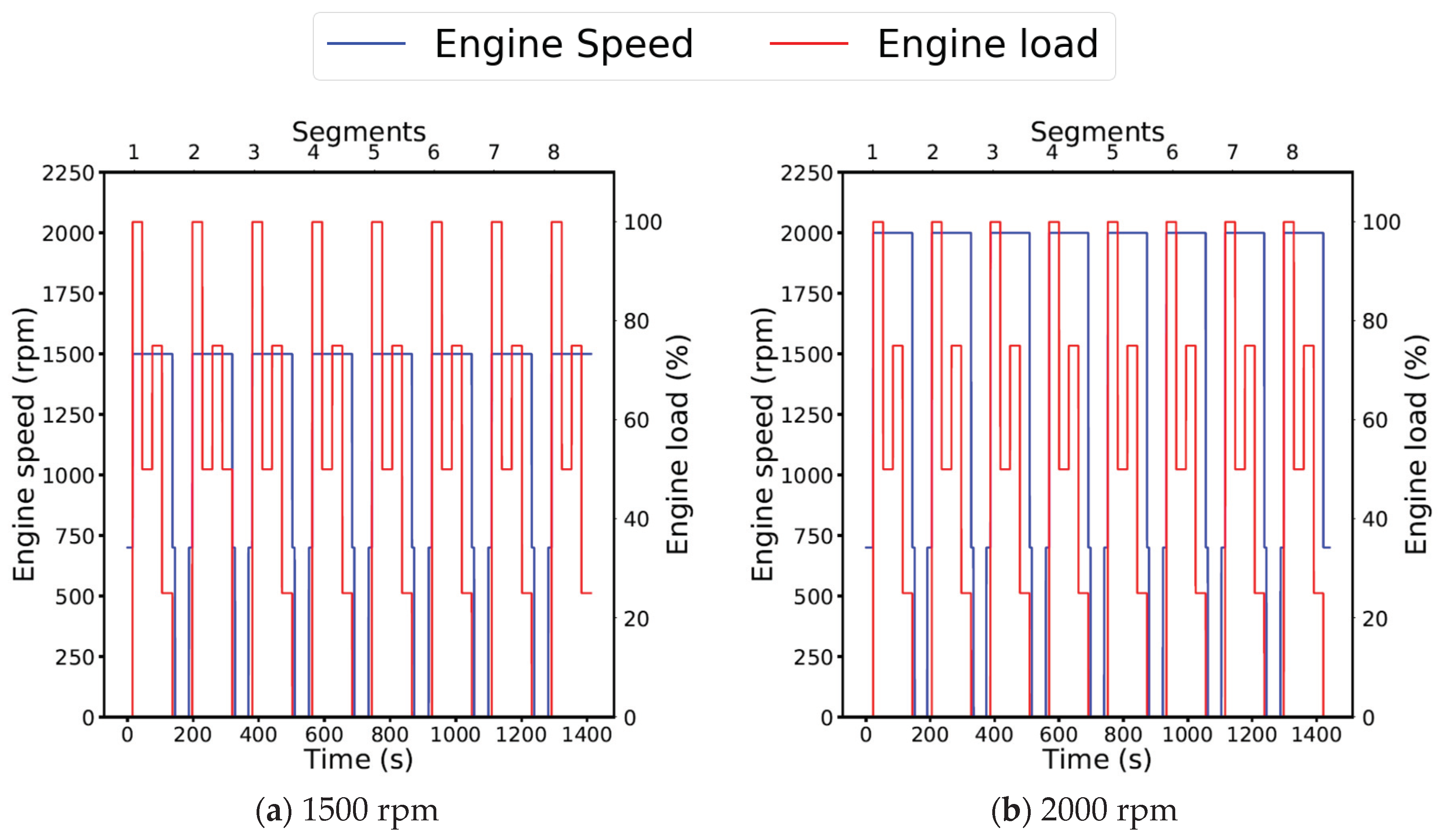
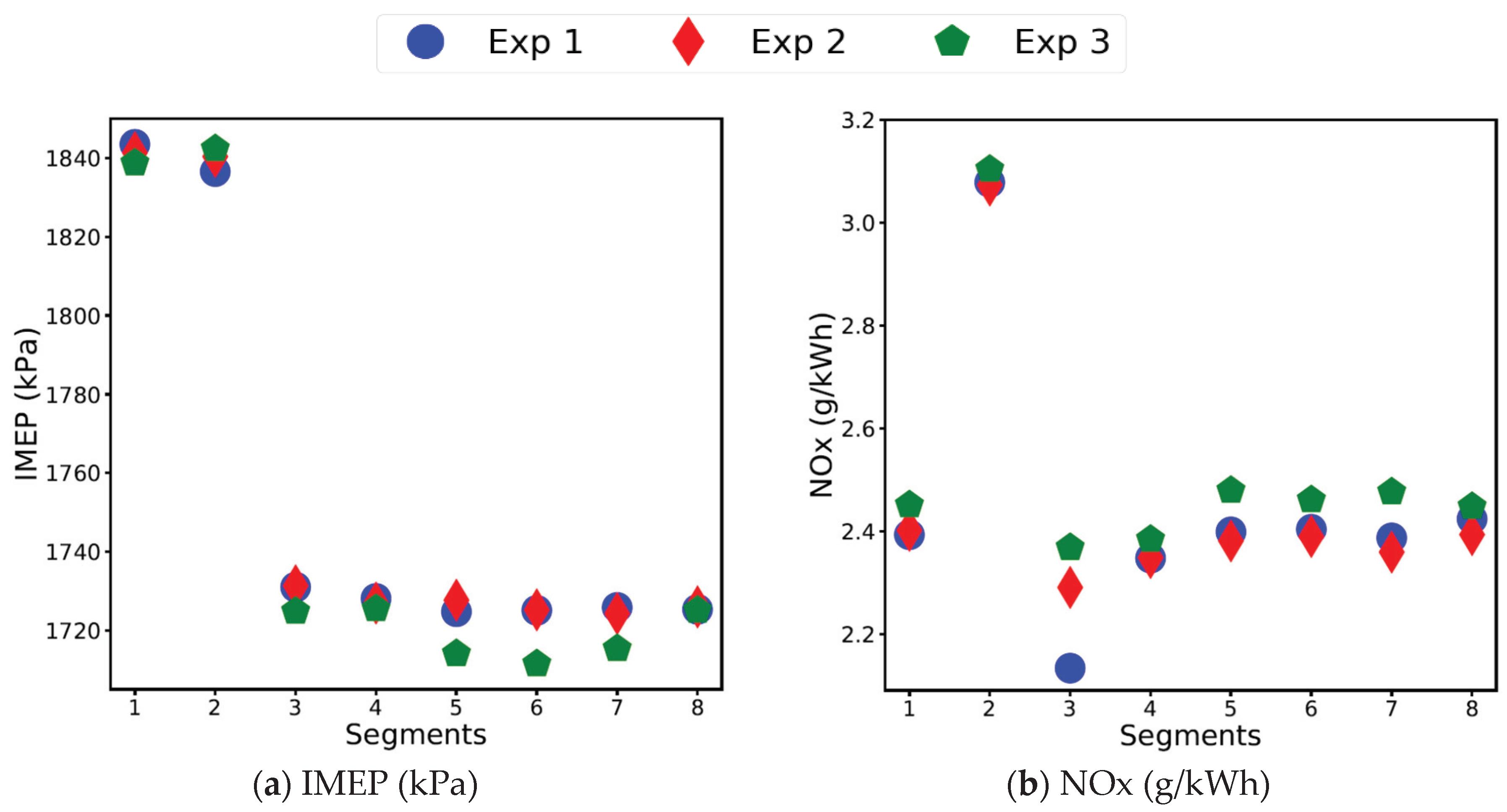
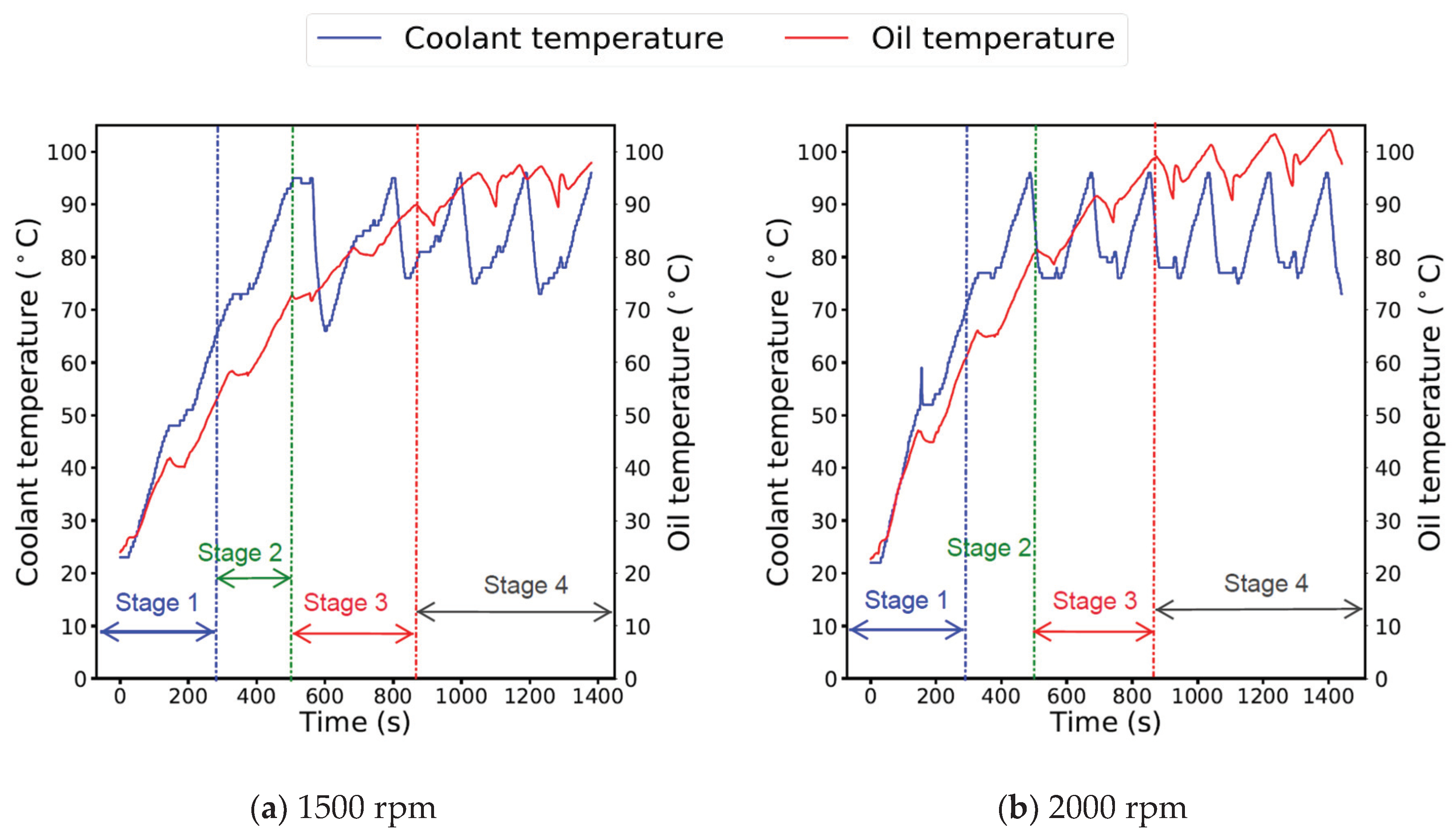
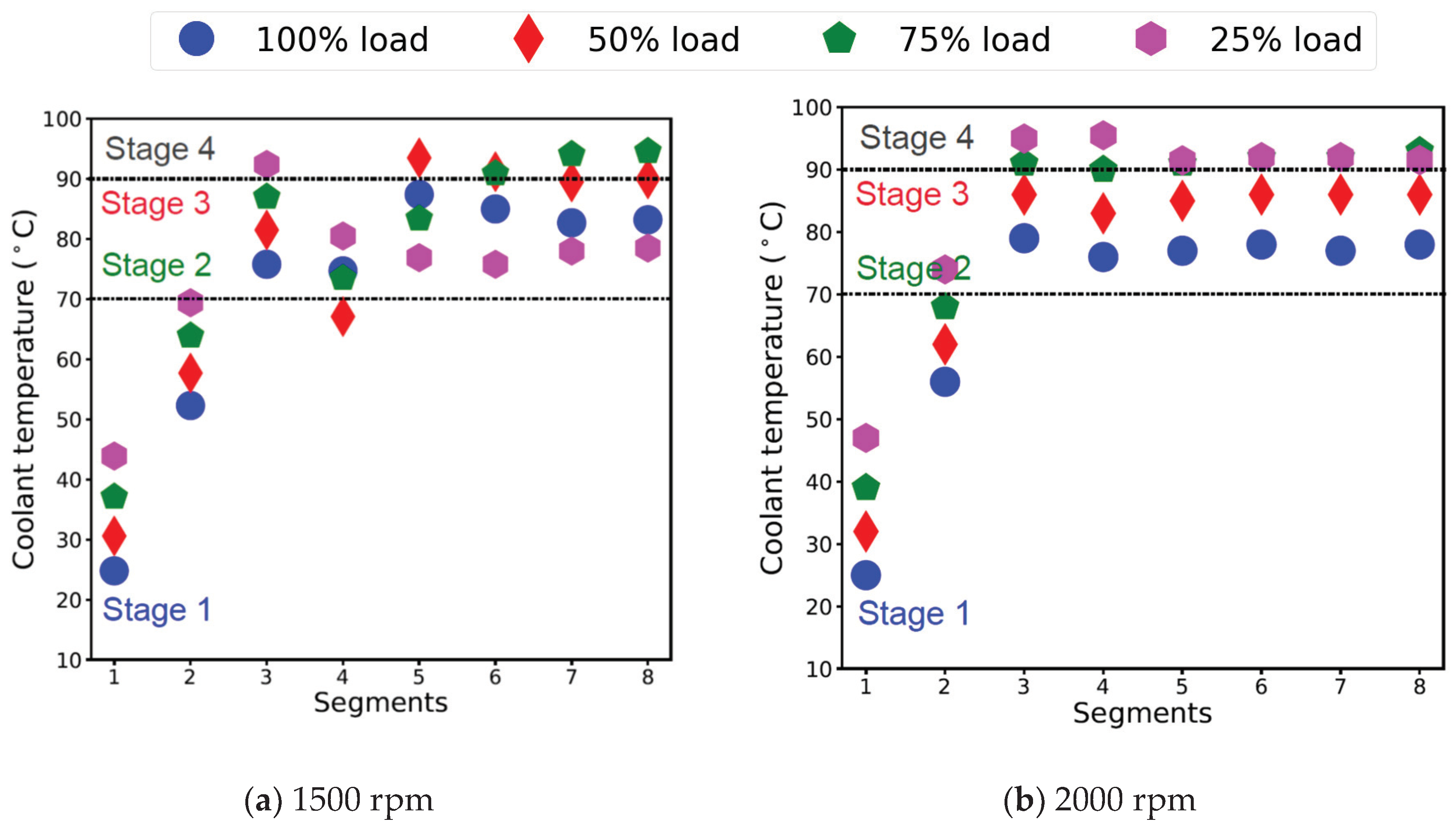
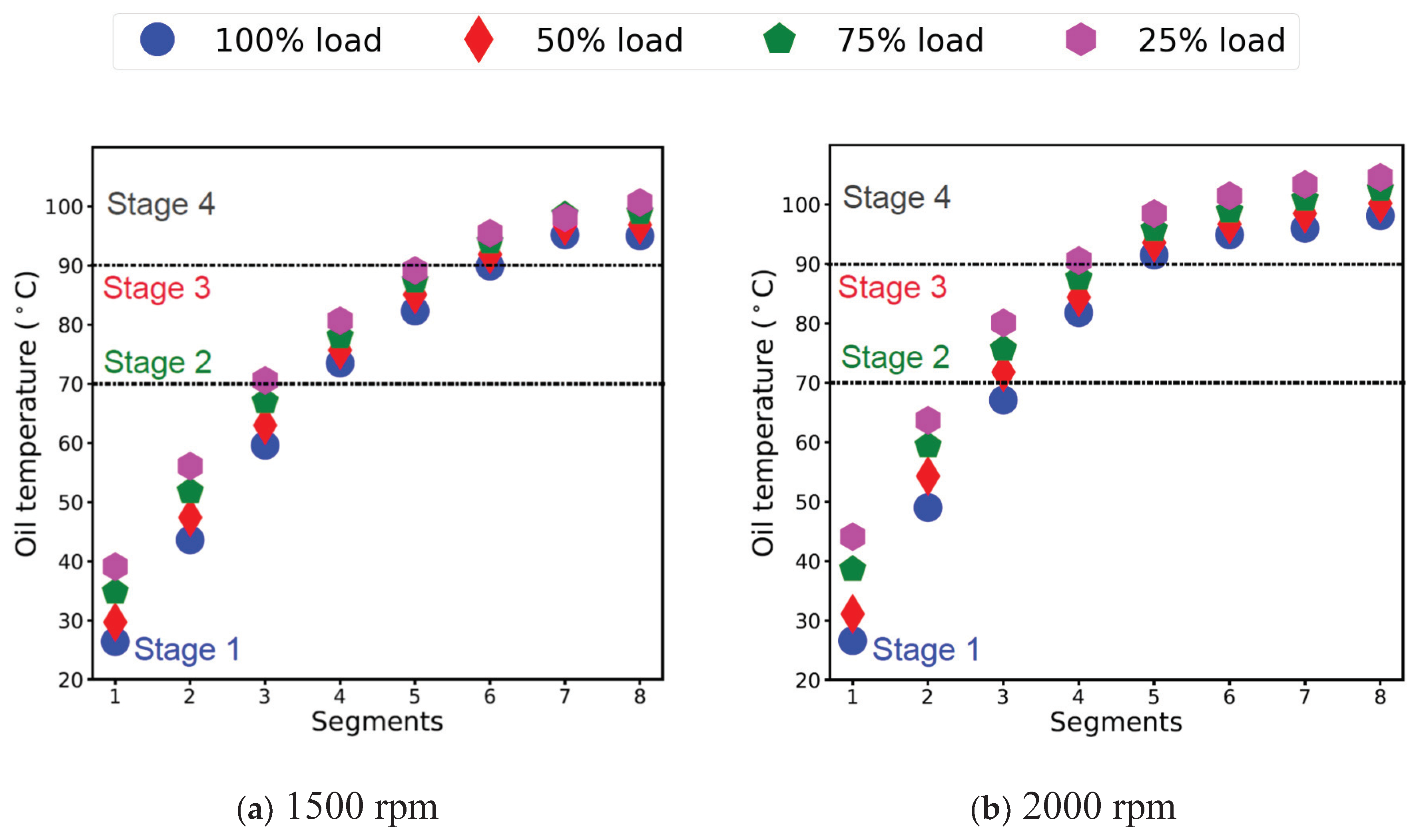
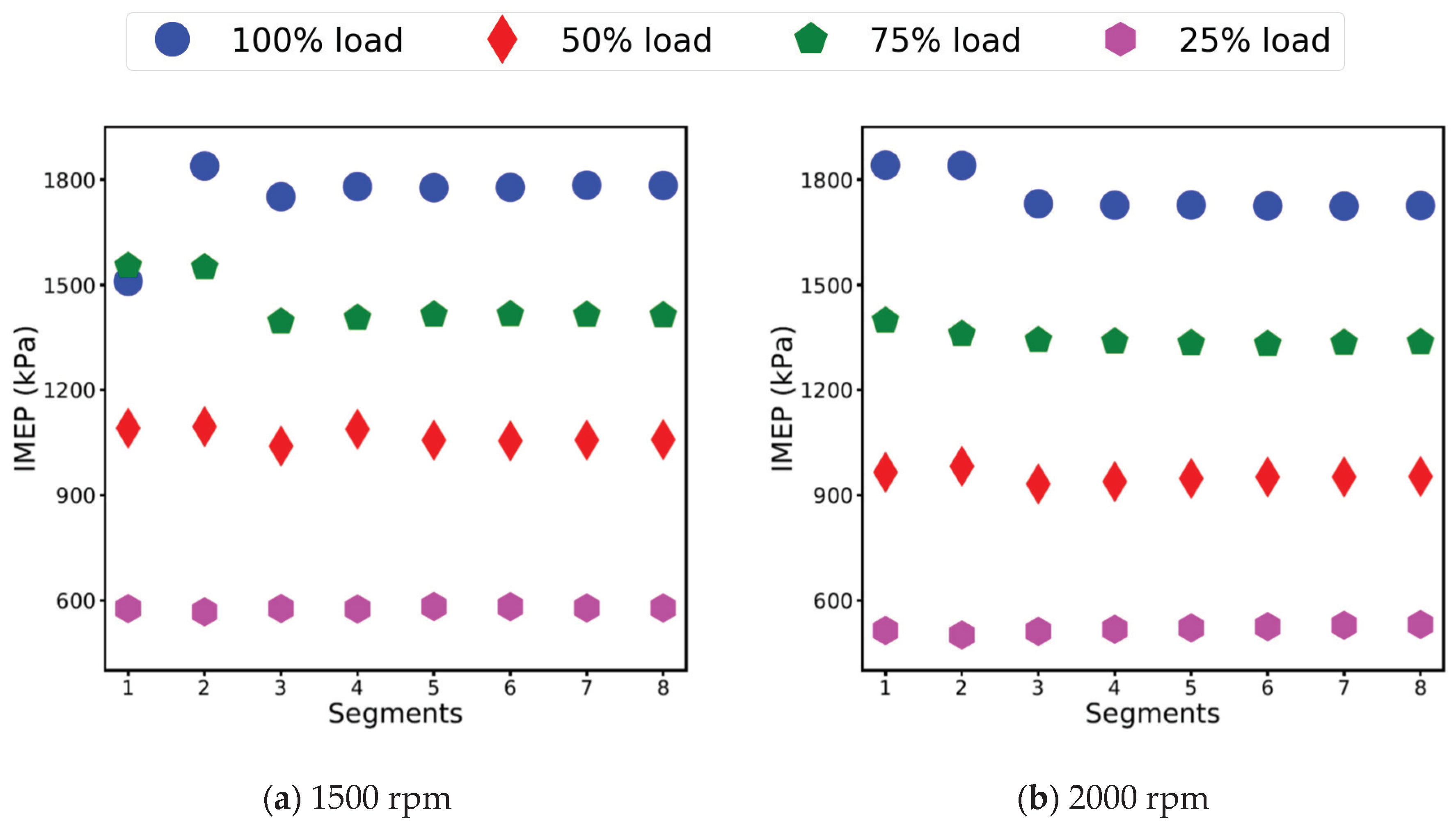
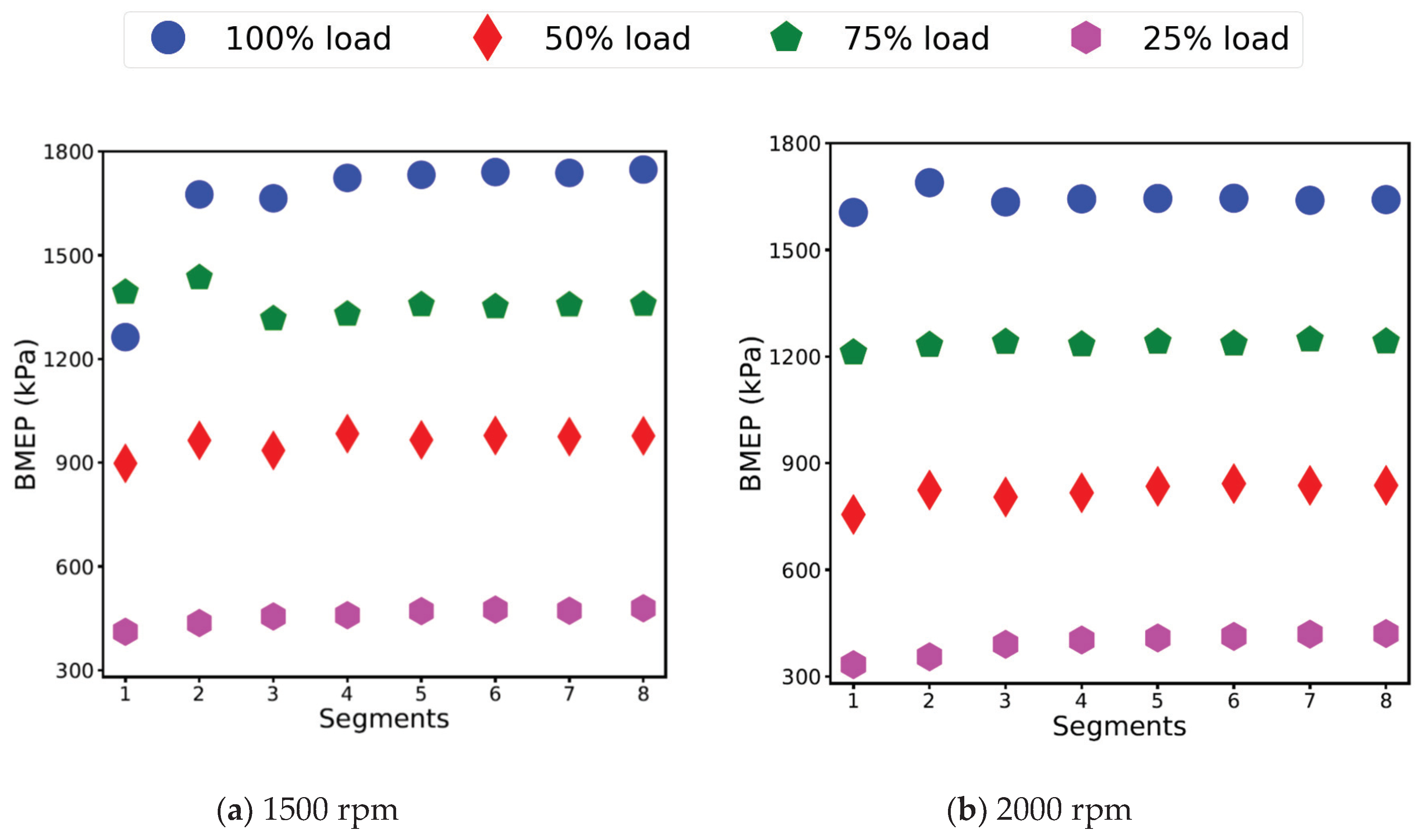
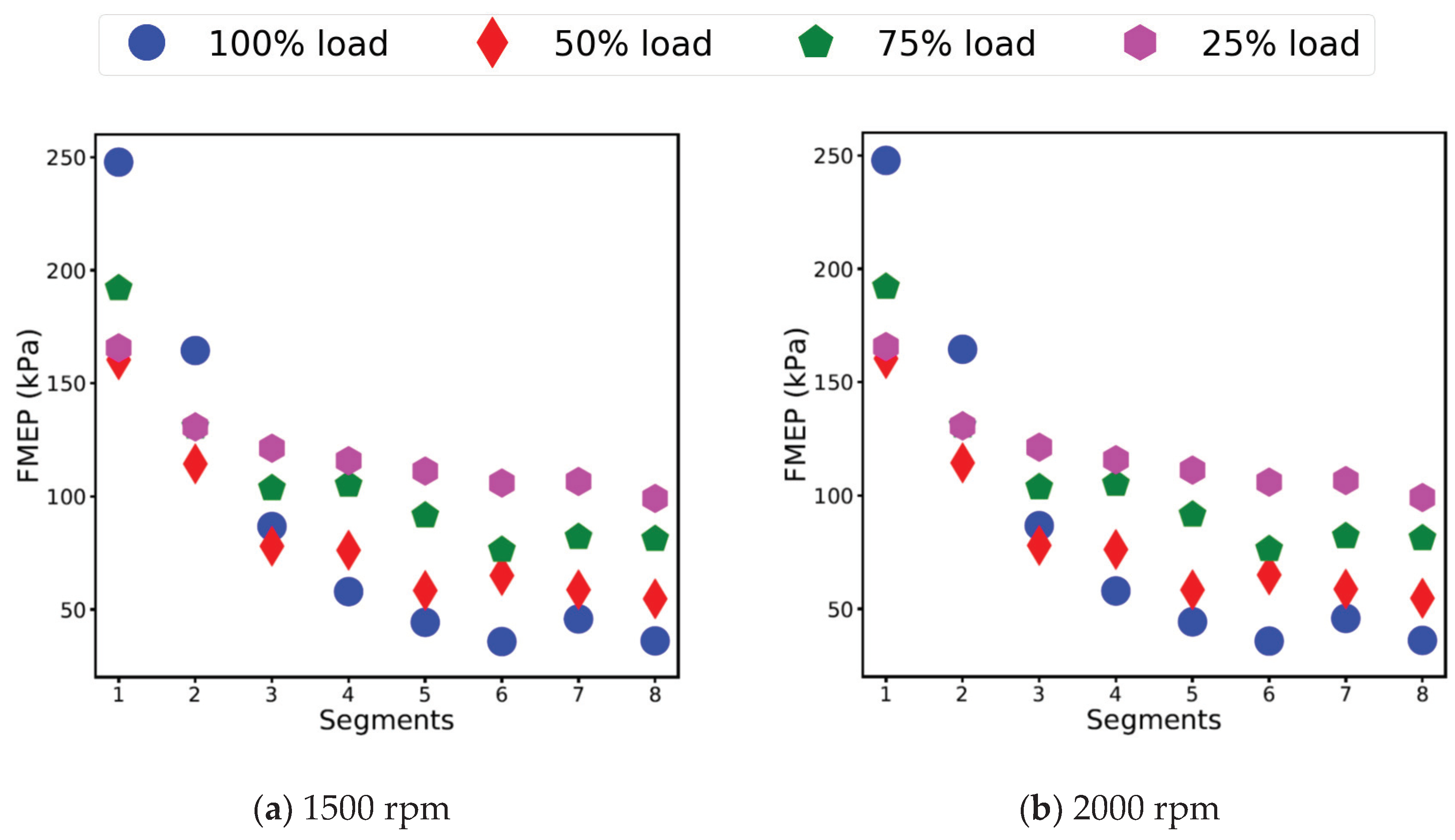

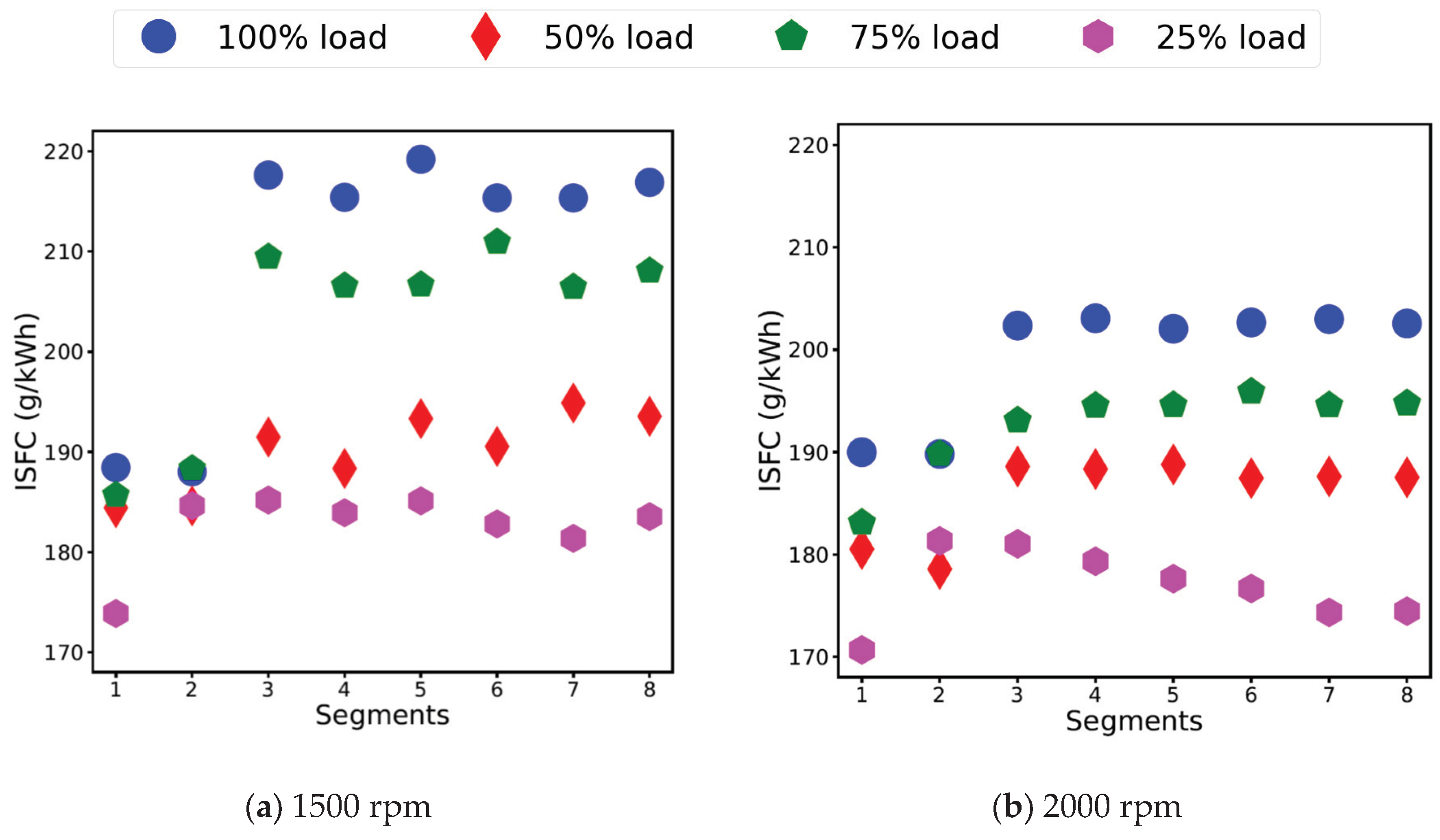


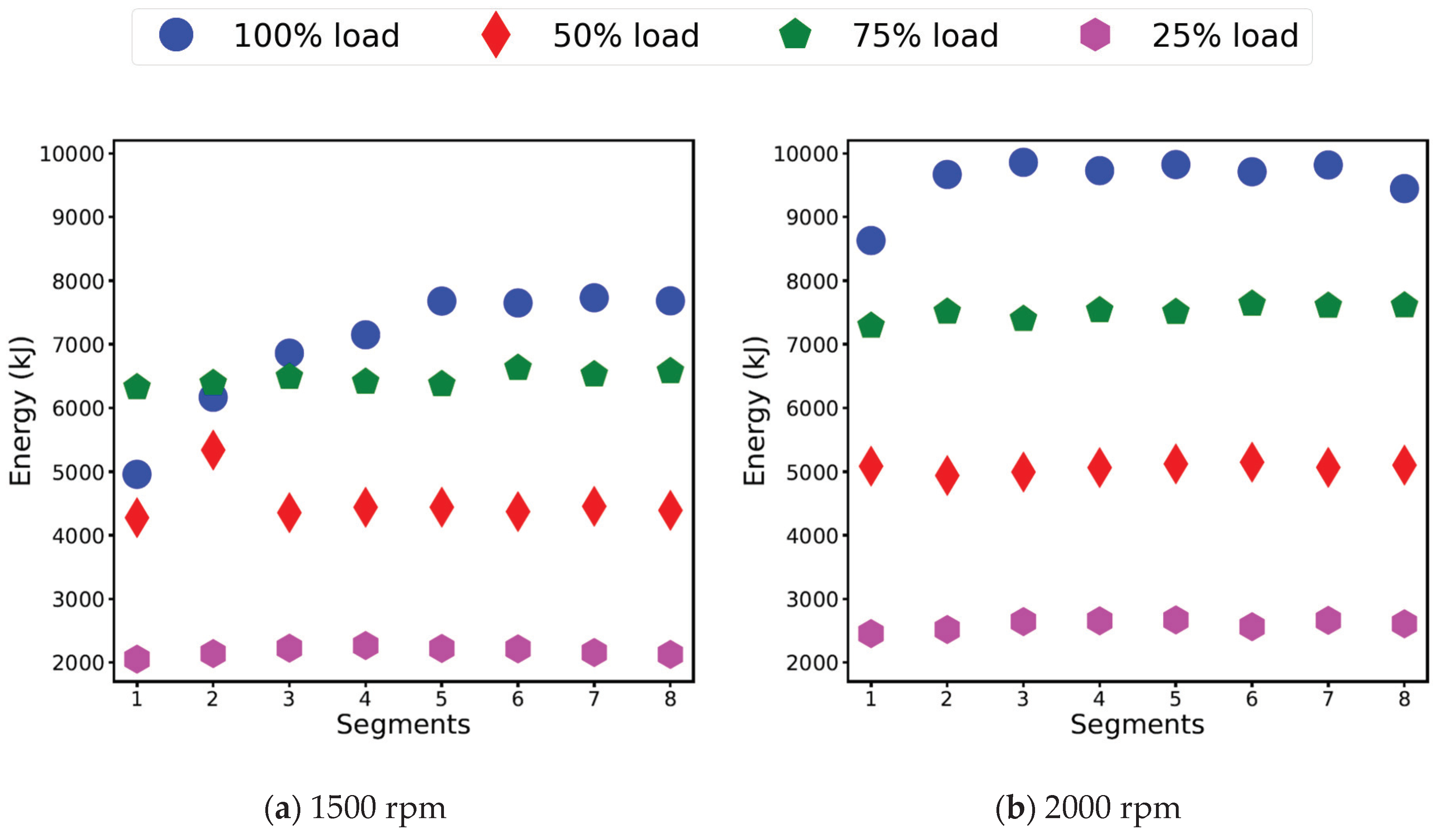
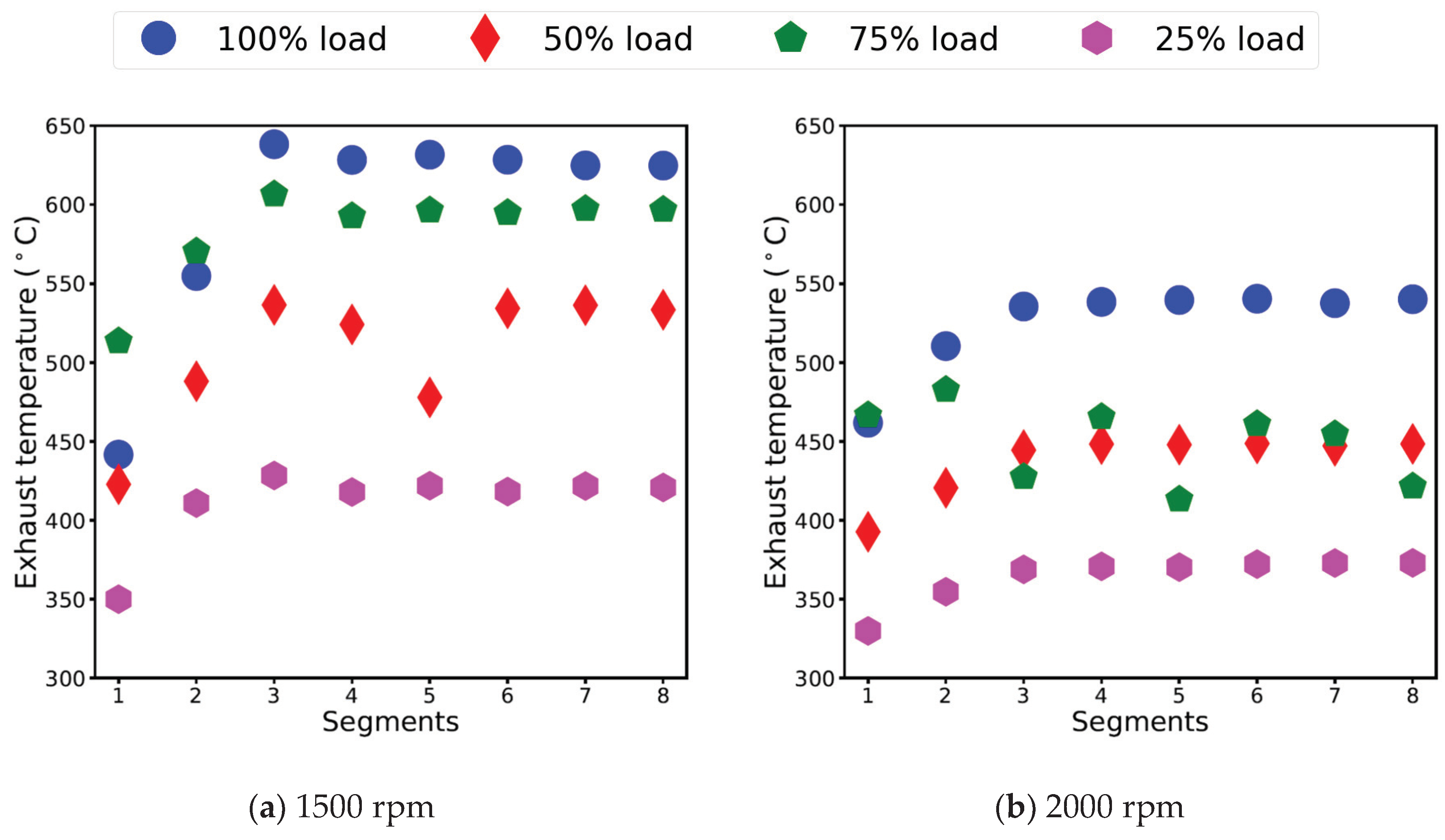
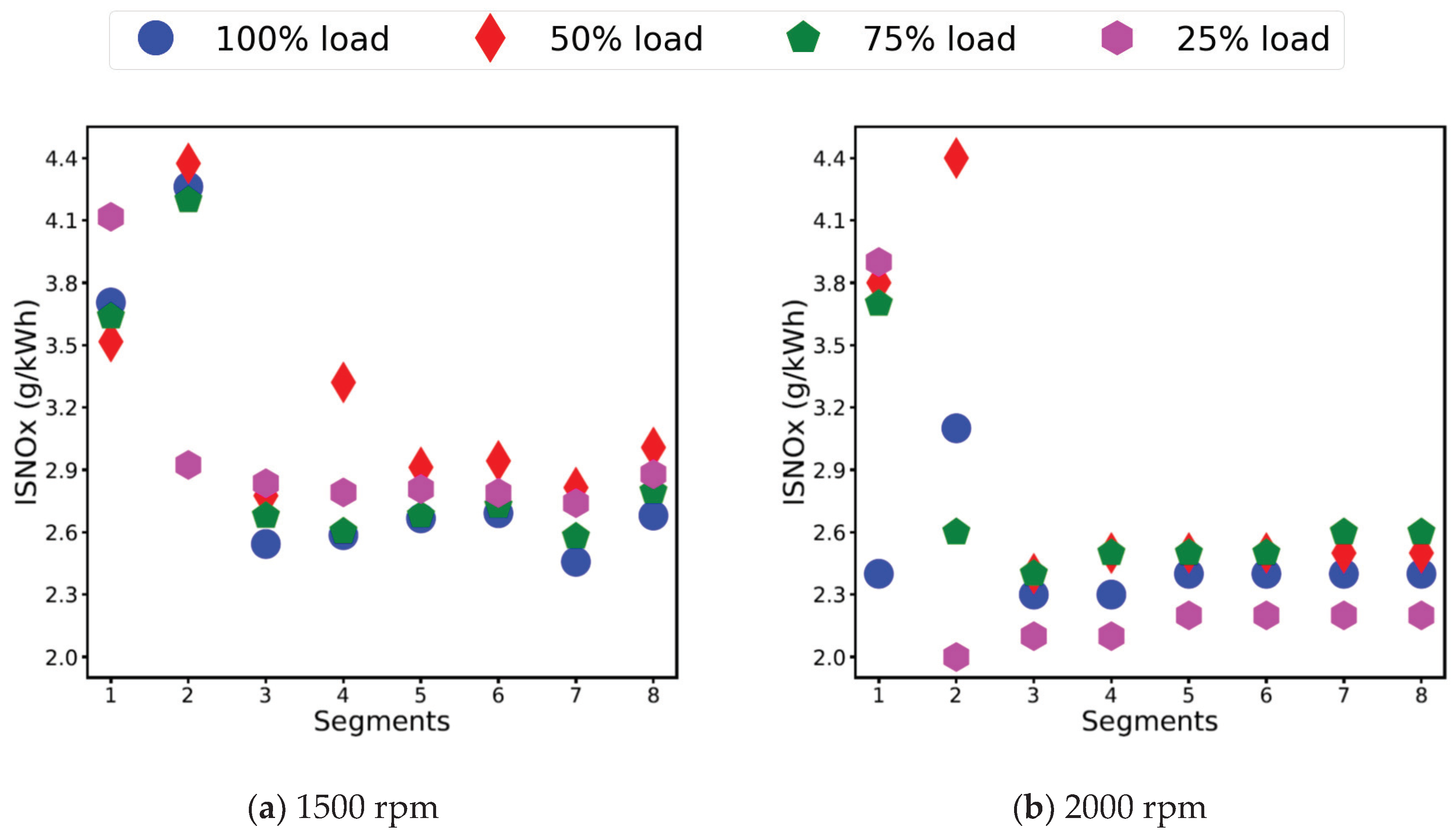
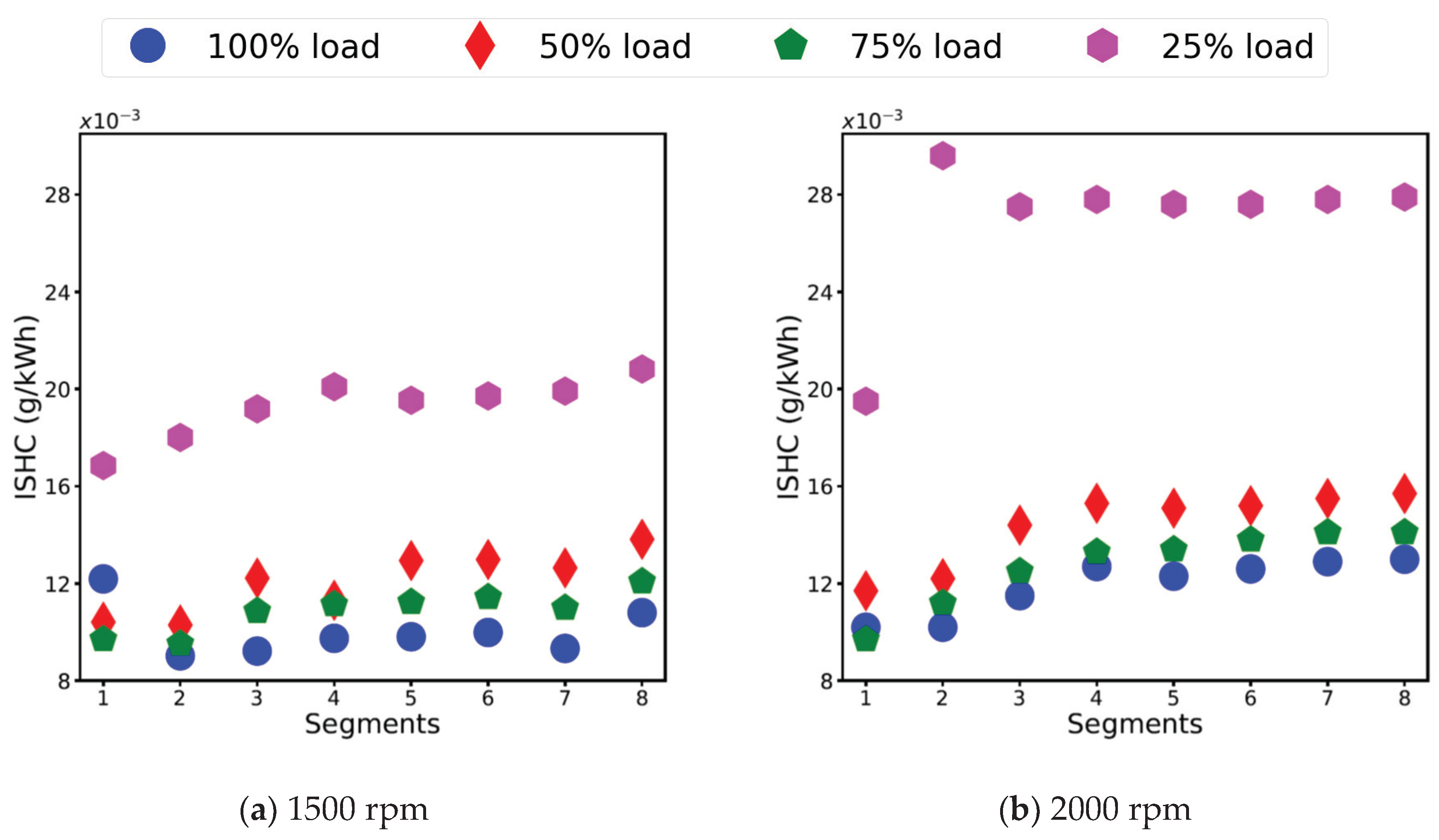

| S. No | Model | Cummins ISBe220 31 |
|---|---|---|
| 1 | Cylinders | 6 in-line |
| 2 | Capacity | 5.9 L |
| 3 | Bore x stroke | 102 × 120 (mm × mm) |
| 4 | Connecting rod | 220 mm |
| 5 | Maximum power | 162 kW @ 2000 rpm |
| 6 | Maximum torque | 820 Nm @ 1500 rpm |
| 7 | Compression ratio | 17.3:1 |
| 8 | Aspiration | Turbocharged |
| 9 | Fuel injection | High pressure common rail |
| 10 | Emissions standard | Euro III |
© 2020 by the authors. Licensee MDPI, Basel, Switzerland. This article is an open access article distributed under the terms and conditions of the Creative Commons Attribution (CC BY) license (http://creativecommons.org/licenses/by/4.0/).
Share and Cite
Lodi, F.; Zare, A.; Arora, P.; Stevanovic, S.; Jafari, M.; Ristovski, Z.; Brown, R.J.; Bodisco, T. Engine Performance and Emissions Analysis in a Cold, Intermediate and Hot Start Diesel Engine. Appl. Sci. 2020, 10, 3839. https://doi.org/10.3390/app10113839
Lodi F, Zare A, Arora P, Stevanovic S, Jafari M, Ristovski Z, Brown RJ, Bodisco T. Engine Performance and Emissions Analysis in a Cold, Intermediate and Hot Start Diesel Engine. Applied Sciences. 2020; 10(11):3839. https://doi.org/10.3390/app10113839
Chicago/Turabian StyleLodi, Faisal, Ali Zare, Priyanka Arora, Svetlana Stevanovic, Mohammad Jafari, Zoran Ristovski, Richard J. Brown, and Timothy Bodisco. 2020. "Engine Performance and Emissions Analysis in a Cold, Intermediate and Hot Start Diesel Engine" Applied Sciences 10, no. 11: 3839. https://doi.org/10.3390/app10113839
APA StyleLodi, F., Zare, A., Arora, P., Stevanovic, S., Jafari, M., Ristovski, Z., Brown, R. J., & Bodisco, T. (2020). Engine Performance and Emissions Analysis in a Cold, Intermediate and Hot Start Diesel Engine. Applied Sciences, 10(11), 3839. https://doi.org/10.3390/app10113839







